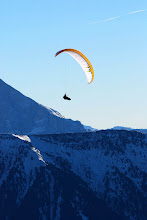EN B
Development and design
„Revolution through evolution“: That's how the development process of the Mentor 3 can be summarized.
The Mentor 2 was our basis: We wanted to refine and improve its well proven characteristics.
The first prototypes showed the huge potential for performance-improvements in seemingly small details. That's why it wasn't necessary to change the basic design of the Mentor 2.
Thus, the Mentor 3 is the result of several well conceived optimisation measures. The technical basic data stayed almost the same. But the leap in performance is the biggest we ever achieved from one model generation to the next.
Flying the Mentor 3
Mentor 2 pilots will immediately feel familiar with its successor: The Mentor 3 offers the same level of stability, compactness and precision.
The steering forces got smaller and the cornering ability has improved. The Mentor 3 can be piloted more relaxed and even more efficiently in thermals. The feedback the pilot receives is softer but still very precise.
The outstanding stability across the entire speed range stayed the same, just with a significantly better glide ratio and with a slightly improved top-speed.
Safety
The results of our extensive test-flights with the Mentor 2 in turbulent air were confirmed: After more than two years, almost 3000 wings and many thousand hours in various conditions, the Mentor 2 has established itself as a very stable and reliable glider.
The DHV confirmed, that the statistical accident analysis shows a very small number of Mentor 2 incidents, based on the number of sold gliders.
One reason for the high level of safety is the very small aspect ratio. This leads to an easy handling behaviour as well as to a considerable safety advantage in the case of a big collapse: The gliders reaction is better calculable and manageable and the risk of a cravatte is reduced.
The basic design (planform, aspect ratio, curvature, airfoil, ...) wasn't changed on the Mentor 3. Accordingly, our tests in bumpy air showed the same stability and even slightly more damping of turbulences. We are confident, that the Mentor 3 will continue the legacy of the Mentor 2 as a safe and predictable high-level B glider.
Performance
The sheer glide performance of a glider is important. But what really matters is the usability of the performance potential in practical conditions:
Pilots need a wing, they can rely on: They need to be sure about a high level of stability as well as a comfortable level of damping. This finally leads to the "overall performance" which made the Mentor 2 so successful.
The Mentor 3 doesn't just have a better glide ratio. (increased by 0.6 across the whole speed range) We also managed to relieve the pilot with a better handling behaviour and with a slightly higher level of damping.
We think that this makes it even easier to use the gliders high performance.
Technical changes compared to Mentor 2
- 3 D Shaping: We didn't invent it, but it's the first time you see this technique on a Nova wing. The 3 D Shaping technique helps to achieve a cleaner leading edge by connecting several convex fabric pieces on the gliders nose.
- Optimized stabilo: The shape of the stabilo is crucial for a gliders performance. We did some small changes which significantly reduced the drag.
- New shape of the leading edge and the of the intakes: The design of the intake determines the internal pressure, which is decisive for a gliders characteristics. (for example for the stability) We tried many different shapes (first in computer simulation, then in flight tests) until we were finally able to improve this part of the wing as well.
- New brake geometry and reefing system: We could reduce the line length and at the same time improve the handling characteristics.
- More info. at www.nova-wings.com


